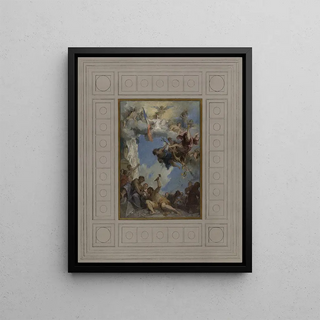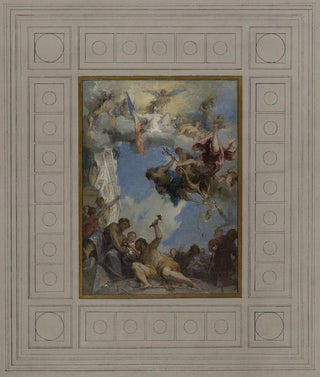Art print | Work under the aegis of the Republic brings abundance and prosperity - Henri Léopold Lévy


View from behind

Frame (optional)
The art print "Le Travail sous l'égide de la République amène l'abondance et la prospérité" by Henri Léopold Lévy is an iconic piece that embodies the republican ideals of 19th-century France. Through this depiction, the artist invites us to contemplate the synergy between labor, prosperity, and the Republic—a message that still resonates today. The artwork, rich in colors and symbolism, evokes the collective strength of society, where each individual contributes to the common edifice. Immersing ourselves in this piece, we discover not only an artistic representation but also a reflection on the human condition and the values that unite a nation.
Style and uniqueness of the work
Lévy's style is characterized by an exceptional mastery of light and color, which gives his compositions an almost living dimension. In "Le Travail sous l'égide de la République amène l'abondance et la prospérité," the figures are depicted with great expressiveness, each bearing the marks of their labor and commitment. The meticulous details of clothing, tools, and faces testify to a particular attention to the social reality of his time. Lévy uses vibrant hues to create a striking contrast between shadow and light, symbolizing the path toward prosperity. This work is also marked by a dynamic composition, where lines and shapes intertwine to guide the viewer's eye across the scene, thus reinforcing the idea of a collective movement toward a better future.
The artist and his influence
Henri Léopold Lévy, a painter of French origin, is often associated with the academic movement, but his work transcends simple classifications. Trained in the ateliers of great masters, he developed a personal style that combines tradition and modernity. Lévy was influenced by the political events of his time, notably the French Revolution and the social struggles that ensued. His commitment to republican values is evident in many works, where he celebrates labor and human dignity. As an artist, he also played a role in shaping collective consciousness

Matte finish

View from behind

Frame (optional)
The art print "Le Travail sous l'égide de la République amène l'abondance et la prospérité" by Henri Léopold Lévy is an iconic piece that embodies the republican ideals of 19th-century France. Through this depiction, the artist invites us to contemplate the synergy between labor, prosperity, and the Republic—a message that still resonates today. The artwork, rich in colors and symbolism, evokes the collective strength of society, where each individual contributes to the common edifice. Immersing ourselves in this piece, we discover not only an artistic representation but also a reflection on the human condition and the values that unite a nation.
Style and uniqueness of the work
Lévy's style is characterized by an exceptional mastery of light and color, which gives his compositions an almost living dimension. In "Le Travail sous l'égide de la République amène l'abondance et la prospérité," the figures are depicted with great expressiveness, each bearing the marks of their labor and commitment. The meticulous details of clothing, tools, and faces testify to a particular attention to the social reality of his time. Lévy uses vibrant hues to create a striking contrast between shadow and light, symbolizing the path toward prosperity. This work is also marked by a dynamic composition, where lines and shapes intertwine to guide the viewer's eye across the scene, thus reinforcing the idea of a collective movement toward a better future.
The artist and his influence
Henri Léopold Lévy, a painter of French origin, is often associated with the academic movement, but his work transcends simple classifications. Trained in the ateliers of great masters, he developed a personal style that combines tradition and modernity. Lévy was influenced by the political events of his time, notably the French Revolution and the social struggles that ensued. His commitment to republican values is evident in many works, where he celebrates labor and human dignity. As an artist, he also played a role in shaping collective consciousness






